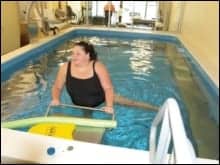The use of virtual reality as a rehabilitation aid after experiencing a stroke may have some effect on the patient’s arm function and activities of daily living.
In the study, published recently in Cochrane Database of Systematic Reviews, researchers compared the use of virtual reality with an alternative intervention or no intervention in its ability to improve upper limb function, cognitive function, activity limitation, participation restriction, and quality of life, according to a news item in Neurology Times.
The results listed in the news item note that the review revealed a statistically significant effect of virtual reality-based rehabilitation on arm function (standardized mean difference (SMD), 0.28; 95% confidence interval (CI), 0.08-0.49) and the activities of daily living (SMD, 0.43; 95% CI, 0.18-0.69). Grip strength, gait speed, or global motor function did not differ significantly, and results for cognitive function, participation restriction, quality of life, or imaging studies could not be analyzed.
Adverse events were rare and relatively mild. Still, the quality of this evidence is low, eligibility rates were only 26%, and the most therapeutically relevant characteristics of virtual reality remain unknown, continues the Neurology Times item.
[Source: Neurology Times]




